
FYI: Nano Gen5 just arrived. Reading about Ledger Recovery Key? Take a moment to see the newest signer!
You probably have a spare key for your house or car, but have you ever stopped to think whether you have one for your crypto? In this Ledger Recovery Key review, I’m taking a closer look at a tool designed to take the stress out of protecting your digital assets.
That small 24-word phrase sheet unlocks your entire crypto portfolio, and losing it is easier than most people think. Imagine misplacing the one slip of paper that holds access to your hard-earned savings. I know I wouldn’t get a decent night’s sleep for days.
Ledger Recovery Key offers a secure backup card that integrates seamlessly with Nano Gen5, Ledger Stax and Ledger Flex. It’s not meant to replace your paper recovery sheet, though, but to give you a secure, low-maintenance backup for that extra peace of mind.
If that sounds like the kind of solution you’ve been missing, let’s see how well it delivers!
Verdict at a Glance:
Ledger Recovery Key is a secure, PIN-protected backup card designed to ease the stress of managing your secret recovery phrase. It’s compact, durable, and quite easy to use. Note that it’s only compatible with newer devices that feature NFC support, such as the Ledger Nano Gen5, Stax and Ledger Flex.
Stop overpaying - start transferring money with Ogvio. Sign up, invite friends & grab Rewards now! 🎁
Pros
- Simple and quick setup process
- Secure offline backup via encrypted NFC
- Secured with a user-set PIN
- Slim, durable, and travel-friendly
- Employs a Secure Element chip
Cons
- Only works with select Ledger devices
Table of Contents
- 1. Ledger Recovery Key Review: Quick Overview
- 2. Who’s Ledger Recovery Key For?
- 3. Advantages
- 4. Limitations
- 5. Security
- 6. Price & Availability
- 7. User Experience
- 8. How to Use Ledger Recovery Key
- 8.1. Back Up Your Secret Recovery Phrase
- 8.2. Restore Access Using Ledger Recovery Key
- 8.3. Reset Your Ledger Recovery Key
- 9. How It Compares to Other Backup Options
- 9.1. Ledger Recovery Key VS Secret Recovery Phrase Sheet
- 9.2. Ledger Recovery Key VS Ledger Recover
- 9.3. Which Option Fits Your Setup?
- 10. Conclusion: Is Ledger Recovery Key Right for You?
Ledger Recovery Key Review: Quick Overview
Is Ledger Recovery Key a cryptocurrency wallet? How much does it cost? I’m guessing you have a dozen similar questions swirling in your head already. To get you up to speed, here’s a sneak peek of everything you need to know before moving into the rest of my Ledger Recovery Key review.
Type | Wallet recovery tool |
Is Ledger Recovery Key safe? | Yes |
Best For | Ledger users seeking secure offline recovery |
Released in | 2025 |
Size | 51mm × 51mm |
Weight | 2.9g |
Operating System | JCOP 4.5 (Secure Element OS) |
Connectivity | NFC only |
Security | PIN protection, encrypted NFC, offline functionality, auto-wipe, EAL6+ Secure Element chip |
Durability Rating | IP68 certified |
Compatible Devices | Ledger Nano Gen5, Ledger Stax & Ledger Flex |
Price | $39 (included with Ledger Nano Gen5/Flex/Stax) |
Customer Support | Email, live chat, and support ticket |
Table: A quick overview of Ledger Recovery Key
Feel free to return to this quick glance anytime you need a refresher. Whether you’re partway through the review or circling back to recall what Ledger Recovery Key is, the table above keeps all the key details within reach.
Latest Ledger Flex Coupon Found:Who’s Ledger Recovery Key For?
Let’s face it, everyone approaches self-custody a little differently. Some feel confident managing their 24-word phrase with nothing more than pen and paper. Others prefer added reassurance without overcomplicating things.
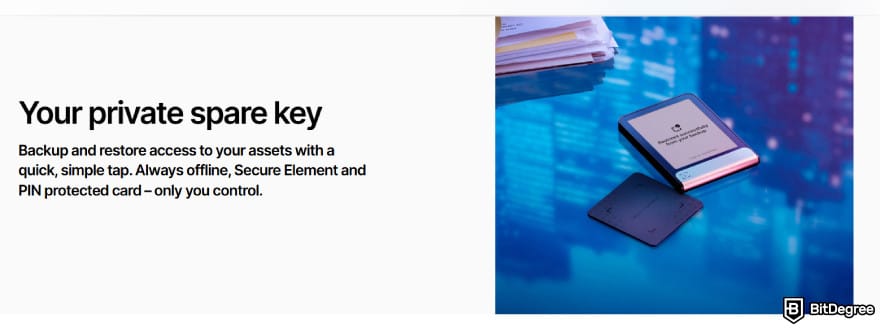 That’s where Ledger Recovery Key comes in. It introduces an extra layer of protection for those who want it. The recovery card isn't here to replace what already works, but to offer another secure way to back up your crypto. As the team puts it:
That’s where Ledger Recovery Key comes in. It introduces an extra layer of protection for those who want it. The recovery card isn't here to replace what already works, but to offer another secure way to back up your crypto. As the team puts it:
It’s designed for users who seek greater optionality in managing their secret recovery phrase, acknowledging that self-custody is personal and a ‘one-size-fits-all’ approach doesn’t apply.
In a world where every setup is different, having options does matter. Whether you lean on handwritten backups, metal storage, or identity-based systems, this card delivers a practical middle ground – balancing simplicity with hardware-grade protection.
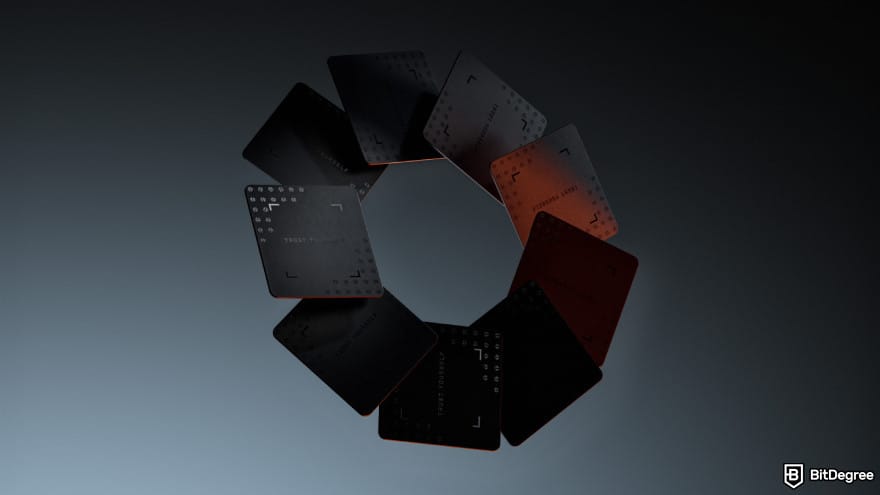 Here’s who I think will get the most value from it and why:
Here’s who I think will get the most value from it and why:
- Security-conscious users. If you believe that redundancy builds resilience, this tool is designed with you in mind. It offers an offline, PIN-protected alternative that complements your existing paper or metal backups.
- Long-term crypto holders. Planning to store a significant amount of crypto for the long haul? This card adds practical resilience to your setup, allowing you to restore access in seconds without manually entering all 24 words.
- Anyone managing more than one wallet. You can use multiple Ledger Recovery Keys to back up different recovery phrases or create redundant backups for the same wallet. Whether it’s for organizational clarity or physical separation, extra cards can give you more reassurance.
And if this form of self-custody doesn’t suit your needs, there are still other options. Ledger Recover, for instance, is a subscription-based service for those who prefer a hands-off backup approach. If you're curious how it compares to its offline counterpart, I’ll break it down later in the Ledger Recovery Key VS Ledger Recover section.

Did you know?
All Crypto Exchanges may look similar to you but they're NOT all the same!
Advantages
Now that you know who Ledger Recovery Key is best suited for, let’s take a closer look at some aspects that impressed me. These are the standout features I noticed during testing, and a few might even surprise you in the best way.
- Quick, hassle-free setup;
- Offline operation with encrypted NFC;
- PIN protection for added security;
- Compact, durable, and discreet build;
- Open-source logic for transparency.
Managing crypto self-custody already comes with its fair share of responsibilities.[1] So I was relieved to find that Ledger Recovery Key doesn’t add to the burden.
The setup is refreshingly simple: follow a few on-screen prompts, set a PIN, tap the card to your wallet, and that’s it. Your master secret is securely stored within minutes.
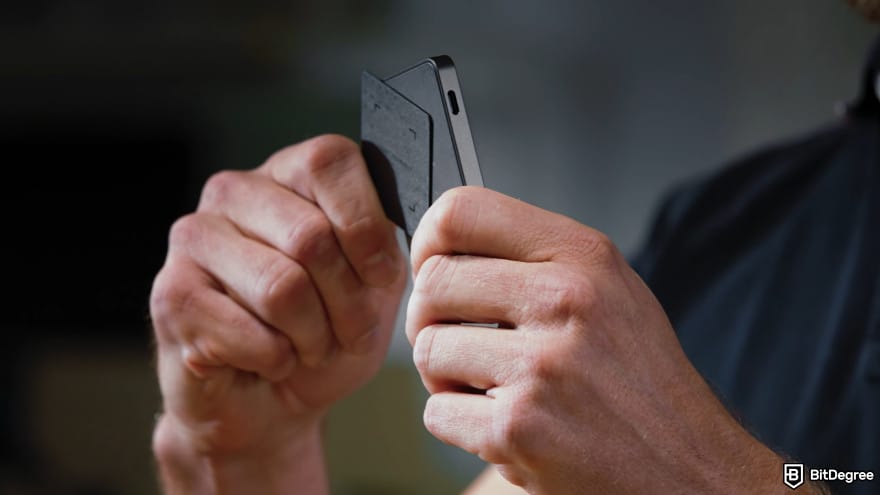 You might wonder, though, “Is Ledger Recovery Key safe for backing up something so important with such a short process?” A fair question, and the answer is yes.
You might wonder, though, “Is Ledger Recovery Key safe for backing up something so important with such a short process?” A fair question, and the answer is yes.
That confidence comes from its encrypted NFC connection. It ensures every transfer between your wallet and the card happens through a locked-down, offline channel.
But what if the card falls into the wrong hands? That’s where the PIN comes in. The device is secured with a 4- to 8-digit PIN that only you know. And, as with Ledger wallets, three wrong attempts trigger a complete wipe, making unauthorized access impossible.
When it comes to build quality, the card balances form and resilience. It’s slim and light, yet feels sturdy in hand. With IP68 certification, it’s protected against dust and can withstand short-term water exposure.
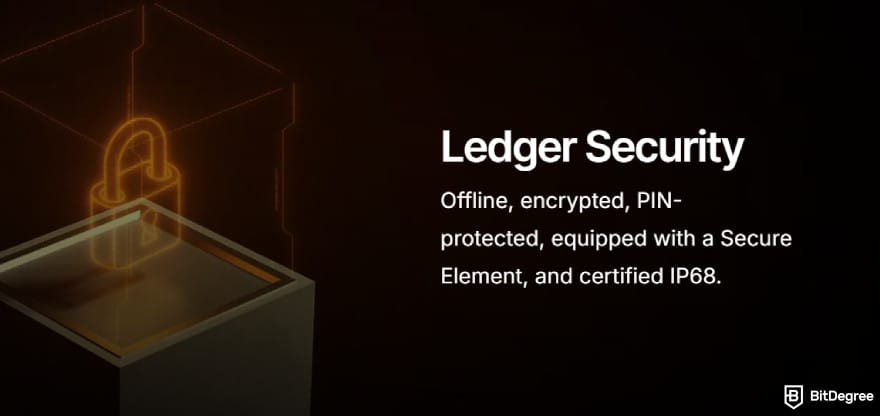 Finally, the open-source logic behind the Recovery Key app adds a meaningful layer of transparency. Much of the code is publicly available on GitHub, giving anyone the ability to inspect and verify how it works.
Finally, the open-source logic behind the Recovery Key app adds a meaningful layer of transparency. Much of the code is publicly available on GitHub, giving anyone the ability to inspect and verify how it works.
This level of openness does more than build trust. It reinforces the app’s integrity, enhances its security posture, and supports consistent performance, qualities that are essential for staying resilient against the ever-evolving cybersecurity threats.[2]
In short, Ledger Recovery Key offers added protection, intuitive usability, and long-term peace of mind without adding friction to your self-custody setup.
📚 Check Out: The Power of Crypto Self-Custody
Limitations
While I’ve pointed out some clear strengths in this Ledger Recovery Key review, there’s a notable drawback worth mentioning.
- Limited device compatibility.
At the time of writing, the Recovery Key only works with three specific devices: Ledger Nano Gen5, Ledger Stax and Ledger Flex. These are the only models that include both a secure touchscreen and built-in NFC, two features required for the card to function as intended.
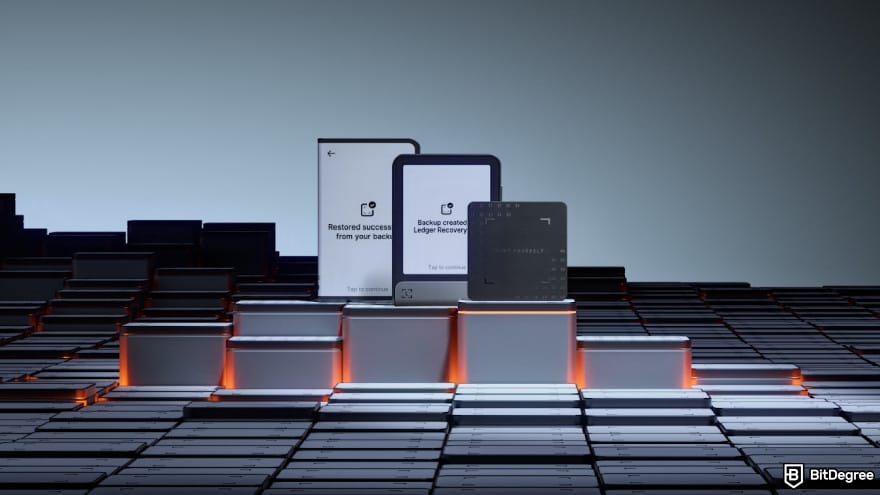 If you’re using an older device, let’s say Ledger Nano X, this backup solution won’t work out of the box. To use it, you’ll need to upgrade to one of the newer touchscreen-enabled devices, which might be a dealbreaker if you weren’t planning to switch anytime soon.
If you’re using an older device, let’s say Ledger Nano X, this backup solution won’t work out of the box. To use it, you’ll need to upgrade to one of the newer touchscreen-enabled devices, which might be a dealbreaker if you weren’t planning to switch anytime soon.
Security
So, is Ledger Recovery Key a safe addition to your self-custody setup? Based on everything I’ve tested and seen, I’d say yes.
To start, the recovery card uses a standard-grade Secure Element chip, the same tamper-resistant hardware found in passports and credit cards. It runs on the JCOP 4.5 operating system, and together they’ve been certified at Common Criteria EAL6+, one of the highest security ratings available for consumer hardware.
.jpg) This level of certification signals that the chip is engineered to resist physical tampering and protect your private data from even sophisticated threats.
This level of certification signals that the chip is engineered to resist physical tampering and protect your private data from even sophisticated threats.
But security doesn’t stop at storage. The data transfer process is tightly controlled.
Every time you back up or restore your recovery phrase, the card and your Ledger wallet communicate via encrypted NFC. Each side verifies the other before any information is shared, blocking unauthorized or counterfeit devices from accessing or injecting data.
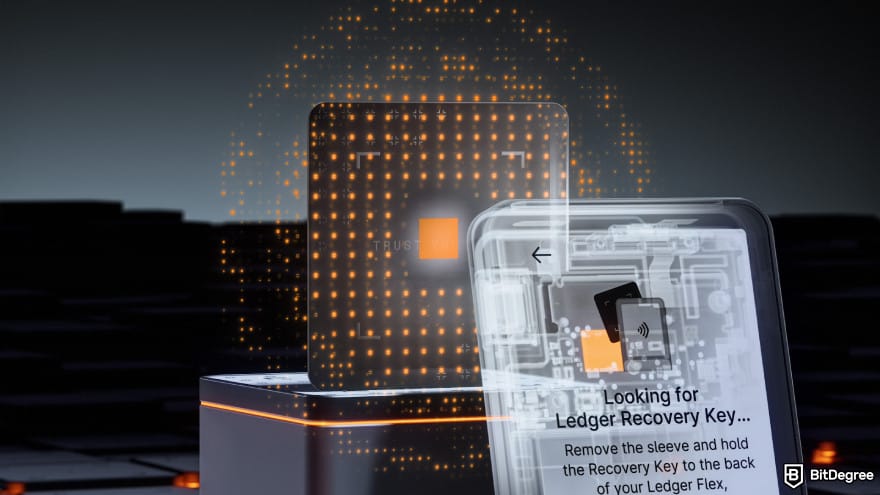 Even in the worst-case scenario (someone steals your card), your 4- to 8-digit PIN acts as a robust defense. After three incorrect attempts, the device automatically resets to factory settings, erasing the stored master key.
Even in the worst-case scenario (someone steals your card), your 4- to 8-digit PIN acts as a robust defense. After three incorrect attempts, the device automatically resets to factory settings, erasing the stored master key.
Lastly, Ledger balances protection with accountability. While the Secure Element’s OS remains closed-source to guard against deep-level exploits, the Recovery Key app’s business logic is open-source and audited. Developers and researchers can review how it works, which should give you added confidence in the system's transparency and integrity.
📚 Check Out: Crypto Wallet Security
Price & Availability
As a physical backup for your digital assets, Ledger Recovery Key comes with a one-time cost only. Once it’s in your hands, it’s completely yours; no account registration, no subscription fees, and no hidden charges to unlock full functionality.
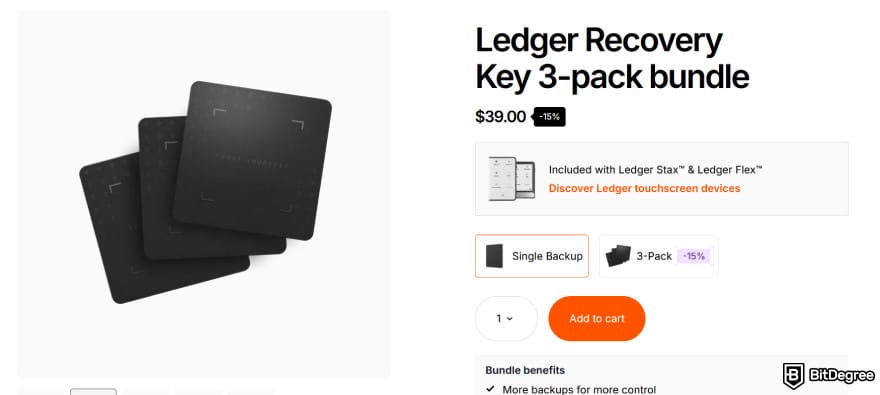 Even better, starting 24th July 2025, the Recovery Key is bundled with every new touchscreen Ledger device. When you purchase a Ledger Flex, Nano Gen5, or Ledger Stax, you’ll find it included in the box for free!
Even better, starting 24th July 2025, the Recovery Key is bundled with every new touchscreen Ledger device. When you purchase a Ledger Flex, Nano Gen5, or Ledger Stax, you’ll find it included in the box for free!
That said, if you’d rather purchase one separately (say you want to set up a secondary backup), Ledger also offers standalone purchase options.
Purchase Option | Price |
|---|---|
Ledger Recovery Key | $39 |
3-Pack Set | $99 |
Table: Ledger Recovery Key price breakdown
I wouldn’t go as far as calling Ledger Recovery Key price cheap. But considering the level of added security and control it provides, the price feels well justified.
Ask yourself this: would you sleep better knowing your recovery phrase is securely backed up, stored offline, and protected by a PIN?
If the answer is yes, then $39 seems like a fair exchange for that extra peace of mind.
Already own a Ledger Stax or Ledger Flex? You can claim a free Recovery Key until the 30th of August 2025.
User Experience
Well, I figured this Ledger Recovery Key review wouldn’t be complete without sharing my firsthand experience. So here’s how it went for me.
Right out of the box, the card looked smaller and squarer than a standard credit card, just a bit thicker. It has a matte finish that gives off a sleek, techy vibe. Despite being made of plastic, it felt pretty solid in hand – not flimsy or cheap in the slightest.
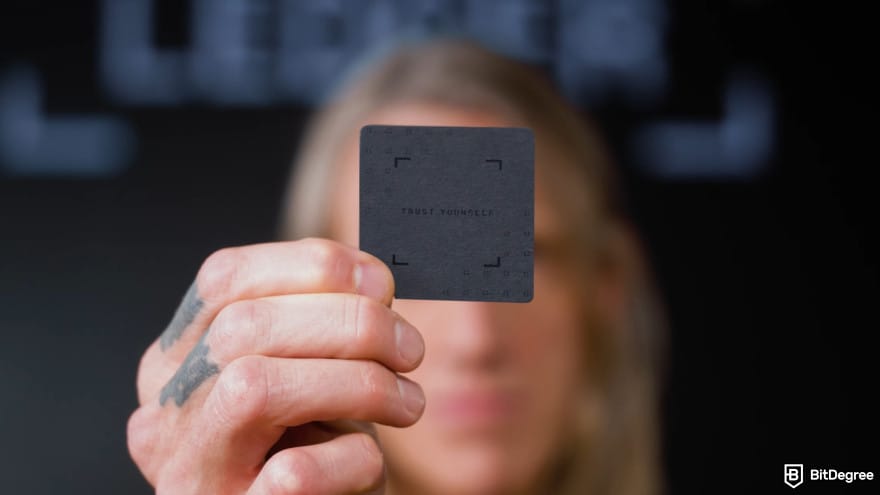 I used my Ledger Stax to begin the setup. The option appeared under settings as “Ledger Recovery Key”. It’s not front and center, but once you know what to look for, it’s easy enough to find.
I used my Ledger Stax to begin the setup. The option appeared under settings as “Ledger Recovery Key”. It’s not front and center, but once you know what to look for, it’s easy enough to find.
One thing I appreciated about the setup flow is that it does more than just walk you through the steps. It also explains why each one matters, which makes the process feel more intentional and easier to repeat later.
The first prompt asked me to scan the Recovery Key by holding it to the back of my Stax. The NFC connection kicked in instantly, and the pairing was seamless. For the PIN setup, I chose a 6-digit code, though the system supports anything from 4 to 8 digits.
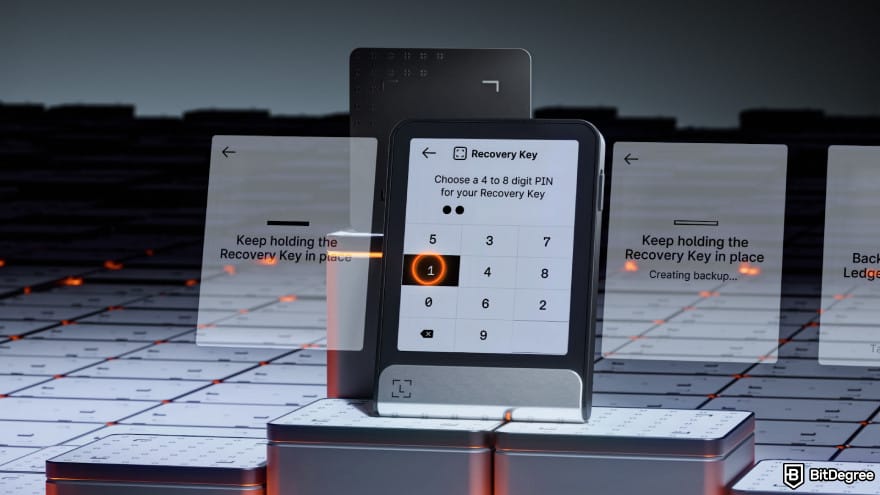 After that, I gave the card a name. This step is completely optional, but handy if you plan to use more than one backup later. The second NFC scan took a few more seconds, but once it finished, that was it: my recovery phrase was backed up, secured with a PIN, and stored offline.
After that, I gave the card a name. This step is completely optional, but handy if you plan to use more than one backup later. The second NFC scan took a few more seconds, but once it finished, that was it: my recovery phrase was backed up, secured with a PIN, and stored offline.
Then, I slipped the card into the included RFID sleeve and stored it in a safe place. Technically, you could carry it in your pocket wallet, but I’d personally recommend storing it in a more secure spot.
All in all, I don’t have any real complaints. The Ledger Recovery Key works reliably as an offline backup for your secret recovery phrase. It might not be a must-have for everyone, but it’s a useful addition, especially if you’re security-conscious like me and prefer having extra layers of protection for your crypto stash.
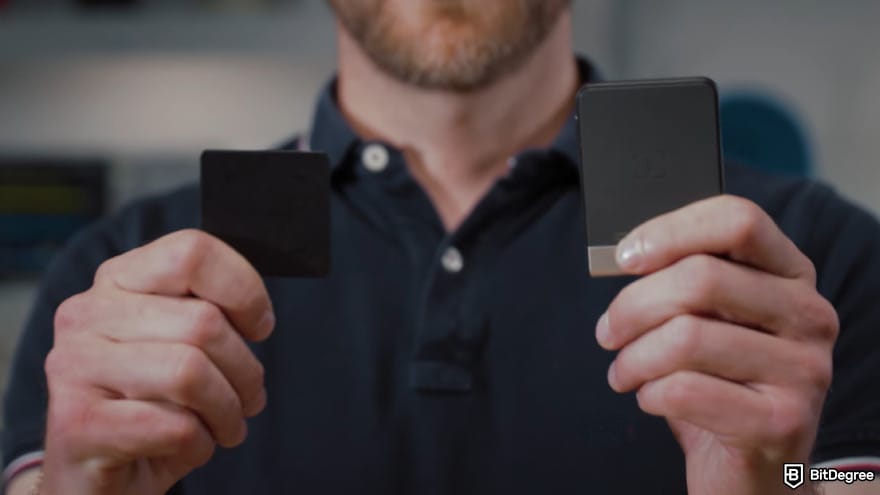 Besides, it comes free in the box with every new Ledger Stax, Nano Gen5, and Ledger Flex. So if you’re thinking about upgrading from an older device or picking up your first hardware wallet, that bundled bonus makes the deal even more appealing.
Besides, it comes free in the box with every new Ledger Stax, Nano Gen5, and Ledger Flex. So if you’re thinking about upgrading from an older device or picking up your first hardware wallet, that bundled bonus makes the deal even more appealing.
📚 Check Out: Best Hardware Crypto Wallets
How to Use Ledger Recovery Key
You’ve already seen what the card is all about and read my hands-on take throughout this Ledger Recovery Key review. Now, let’s shift gears and walk through the practical side.
As mentioned earlier, the Recovery Key is built to make self-custody not just more secure, but also more manageable. Even if this is your first time using a hardware wallet, the process should feel intuitive and easy to follow.
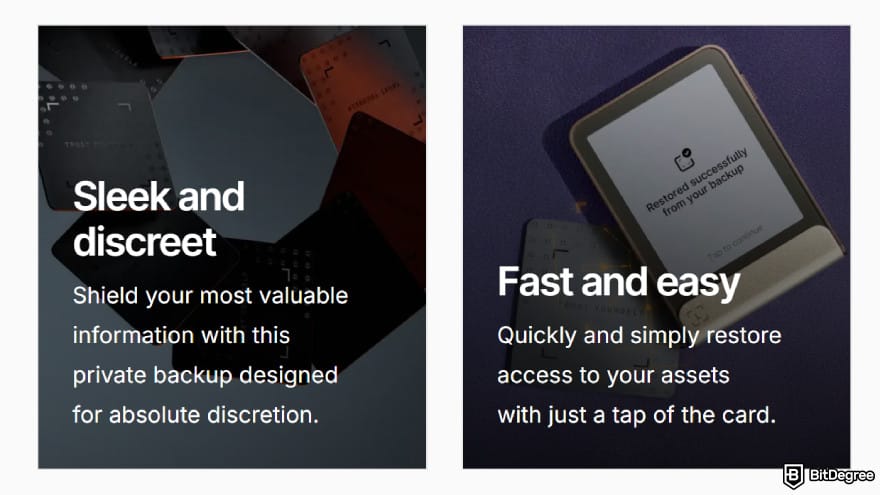 Still, I’ll walk you through the key steps to keep things more manageable. You’ll learn how to back up your recovery phrase, restore access, and reset the card if needed. Before we begin, though, make sure you:
Still, I’ll walk you through the key steps to keep things more manageable. You’ll learn how to back up your recovery phrase, restore access, and reset the card if needed. Before we begin, though, make sure you:
- Have your Ledger Stax, Nano Gen5 or Ledger Flex device ready;
- Install the latest OS version;
- Enable NFC on your device.
If you’ve got all that in place, let’s get started!
Back Up Your Secret Recovery Phrase
Backing up your secret phrase with Ledger Recovery Key takes just a few minutes. All you need is your device and the card itself. Here’s how to do it:
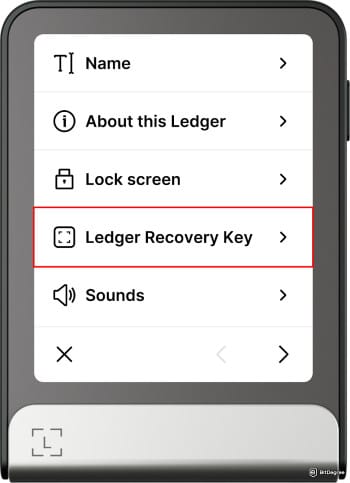
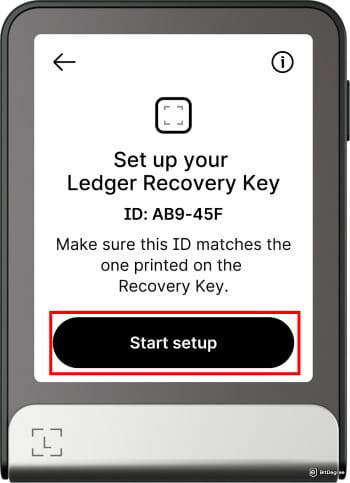
.jpg)
And that’s it! You’ve successfully created a secure, PIN-protected backup of your secret recovery phrase.
Restore Access Using Ledger Recovery Key
If your Ledger device has been reset, replaced, or wiped, you can use your Ledger Recovery Key to restore access without having to manually type in all 24 words.
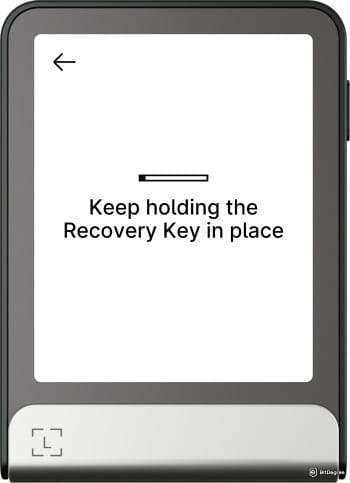
The Ledger Recovery Key doesn’t come with a pre-set PIN. You’ll create one during the initial setup. Choose a PIN that’s memorable for you, but difficult for others to guess.
Your secret recovery phrase will be restored, and your assets will once again be accessible on your device.
Reset Your Ledger Recovery Key
Let’s say you’ve got a new wallet and want to reuse your Recovery Key for a fresh backup. Since the card still holds your old data (master secret, PIN, and name), you’ll need to reset it first.
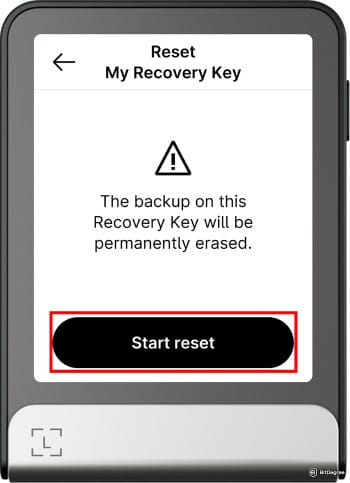
Alternatively, entering the wrong PIN three times in a row will automatically reset the card to factory settings.
Once reset, your Ledger Recovery Key is ready to be set up again with a new wallet.
📚 Read More: An In-Depth Guide on How to Use Ledger Recovery Key
How It Compares to Other Backup Options
By this point in my Ledger Recovery Key review, you’ve seen what the card offers and how it supports the self-custody process. But with other options available, like traditional paper backups or Ledger’s subscription-based service, you might be wondering how this card fits into your overall setup. So, let’s break it down.
Ledger Recovery Key VS Secret Recovery Phrase Sheet
A recovery sheet is the old-school go-to: a piece of paper where you write down your 24-word secret recovery phrase. It’s fully offline, compatible with any BIP39 wallet, and doesn’t require any hardware or software to do its job.
But paper has clear limitations. It can be torn, burned, water-damaged, or misplaced. And if someone gets access to it, your assets are at serious risk.
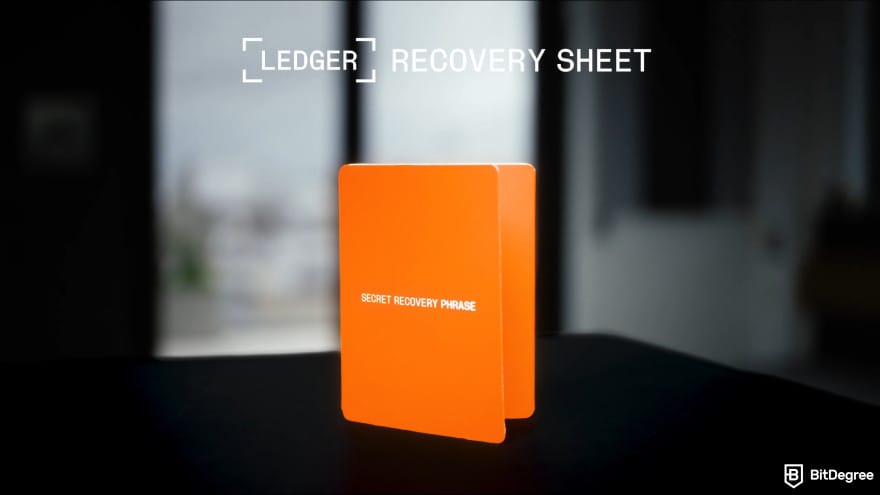 Ledger Recovery Key takes that same phrase and stores it inside a tamper-resistant chip, protected by a PIN. You still get the benefits of offline storage, but with added safeguards. Enter the wrong PIN three times, and the card wipes itself.
Ledger Recovery Key takes that same phrase and stores it inside a tamper-resistant chip, protected by a PIN. You still get the benefits of offline storage, but with added safeguards. Enter the wrong PIN three times, and the card wipes itself.
It’s also water-resistant and communicates securely via NFC with your Ledger device. That makes it more practical for day-to-day use, especially if you’re concerned about handling or losing a paper backup.
That said, Ledger isn’t suggesting you ditch the sheet entirely. You should still write down your recovery phrase and store it securely. What the Recovery Key offers is a convenient backup method, so you don’t need to keep the paper copy within reach at all times.
📚 Read More: How to Recover Ledger
Ledger Recovery Key VS Ledger Recover
At a glance, you might assume Ledger Recovery Key and Ledger Recover are the same thing. After all, both are backup tools for your secret recovery phrase, and the names sound nearly identical. But in practice, they work very differently and are meant for different types of users.
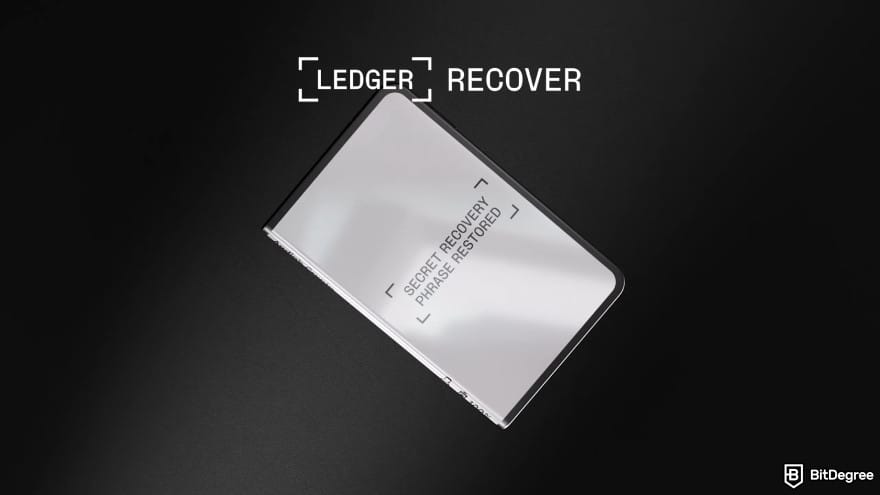 Ledger Recovery Key is an offline backup card. It stores your recovery phrase on a physical card with a tamper-resistant Secure Element chip. There’s no internet connection, no ID verification, and no subscription involved.
Ledger Recovery Key is an offline backup card. It stores your recovery phrase on a physical card with a tamper-resistant Secure Element chip. There’s no internet connection, no ID verification, and no subscription involved.
In contrast, Ledger Recover is an online, subscription-based service that uses identity verification. Once activated, your Ledger device splits an encrypted version of your secret recovery phrase into three fragments and distributes them to three independent service providers.
The biggest difference comes down to trust. Ledger Recover depends on third-party infrastructure and identity-based recovery. Ledger Recovery Key keeps everything in your hands – offline, PIN-protected, and entirely under your control.
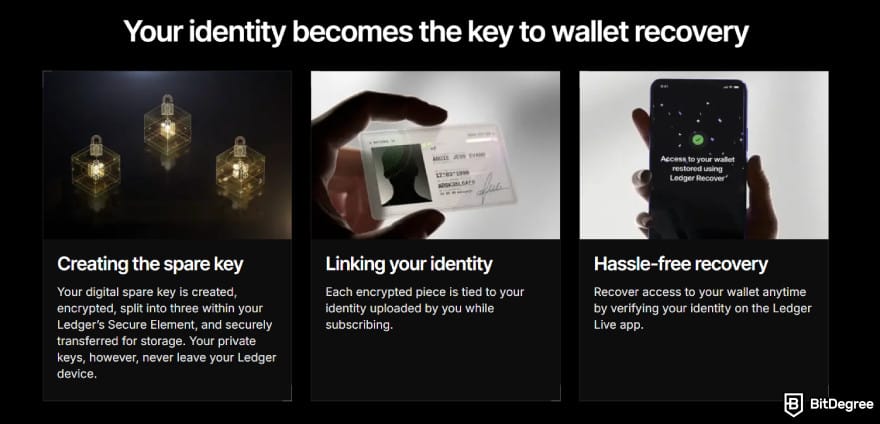
Ledger Recover is ideal for those who prefer convenience and want a hands-off backup option. Ledger Recovery Key, meanwhile, is a better fit for those who value privacy, control, and a more self-sovereign approach to protecting their crypto assets.
📚 Check Out: What is Ledger Recover?
Which Option Fits Your Setup?
Now that you’ve seen how Ledger Recovery Key compares to both the traditional paper method and Ledger’s subscription-based service, here’s a quick breakdown to help you decide which option best aligns with your style.
Recovery Sheet | Ledger Recovery Key | Ledger Recover | |
|---|---|---|---|
Best For | Free basic protection | Offline recovery with added security | Cloud-like convenience with ID-based access |
Works With | All Ledger devices | Touchscreen models only (Stax, Nano Gen5, & Flex) | All Ledger devices |
Security | Fully offline | Fully offline | Online encrypted (fragments only) |
Durability | Very fragile | Robust | Very robust |
Risk of Mistakes | High | Low | Minimal |
Setup & Restore Time | ~10 minutes | ~2 minutes | 15–30 minutes |
Offline | Yes | Yes | No |
Control | Full user control | Full user control | Shared access with ID-based recovery |
Cost | Free | $39 (free with Flex/Stax/Nano Gen5) | ~$99.99/year (subscription) |
Table: Ledger recovery options at a glance
No single solution is perfect on its own, and that’s kind of the point. Each tackles the backup problem from a different angle, whether it’s maximum simplicity, ID-based recovery, or secure hardware storage.
Personally, I see Ledger Recovery Key as a solid middle ground. It doesn’t replace paper backup, but it adds an extra layer of security without complicating the process or shifting control away from self-custody principles.
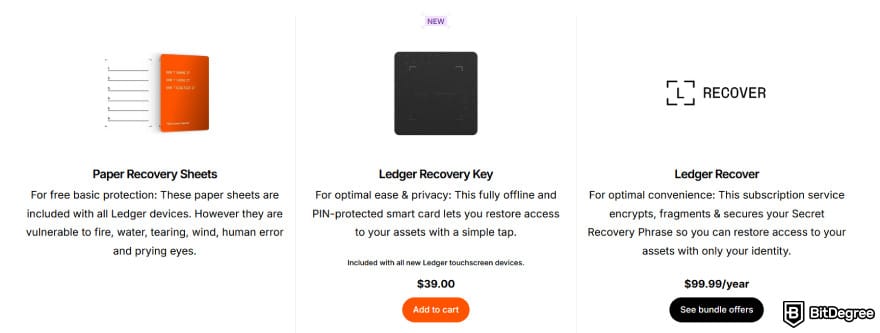 You can also try to combine all three methods. Layer them together and see if it checks every box for your ideal setup.
You can also try to combine all three methods. Layer them together and see if it checks every box for your ideal setup.
📚 Check Out: Crypto Wallet Security
Conclusion: Is Ledger Recovery Key Right for You?
And that brings us to the end of my Ledger Recovery Key review. This PIN-protected backup card reflects Ledger’s effort to make self-custody more approachable without compromising on security.
For what it offers, the price feels fair. It brings added peace of mind to your setup, whether you manage multiple wallets, travel often, or just want something more secure than a paper sheet.
If it sounds like something you’d use, the best deal is definitely with the Ledger Nano Gen5, Ledger Stax, or Ledger Flex. The Recovery Key comes bundled in the box, free of charge!
The content published on this website is not aimed to give any kind of financial, investment, trading, or any other form of advice. BitDegree.org does not endorse or suggest you to buy, sell or hold any kind of cryptocurrency. Before making financial investment decisions, do consult your financial advisor.
Scientific References
1. Milorava D.: ‘Do Users Understand and Want Self-Custody? Insights from an Extended UTAUT Perspective’;
2. Mollakuqe E., Rexhepi S., Bunjaku R., Dag H., Chukwu I. J.: ‘Algorithm for Key Transparency with Transparent Logs’.


